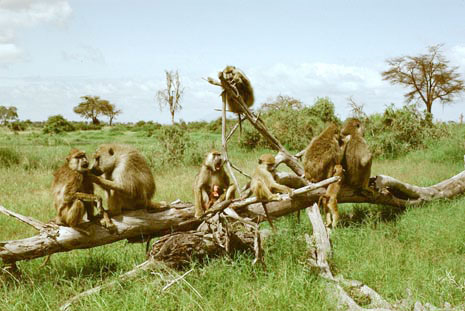
The nature and importance of relatives, dominance rank, and social bonds
Coverage of latest
sociality research:
Monkey's Best Friend, Newsweek, 24Nov03: http://www.msnbc.com/news/994202.asp?cp1=1
Schmooze it or lose it! The Why Files, 13Nov03: http://whyfiles.org/shorties/141baboon_mom/index.html
Baboon mothers do better with friends, Associates Press, 13Nov03: http://www.msnbc.com/news/993281.asp?0sl=-11
Gleaned Social Tips, ABCNews.com, 14Nov03: http://abcnews.go.com/sections/SciTech/US/baboons_psychology_031114-4.html
|
|
In study after study of matrilineal societies, the strong predictive power of maternal relatedness for social associations has been demonstrated; relatives prefer each others' company over the company of nonrelatives in many contexts and preferentially provide support to relatives in agonistic encounters. Almost all studies of matrilineal societies have inferred that these close affiliative bonds with relatives confer fitness advantages and that these bonds have evolved and are maintained through kin selection.
However, recent work
has challenged these inferences. A number of researchers point out that
the simple presence of associations between relatives is not sufficient
evidence for kin selection. West and colleagues [West et al. 2001, Griffin
& West 2002] have illustrated theoretically and empirically that the
competitive costs of living with relatives may outweigh the benefits.
Chapais [2001] has pointed out that associations between maternal relatives
may arise simply as a byproduct of physical proximity to the mother. Further,
in a number of species cooperative relationships that confer fitness advantages
occur between non-relatives rather than relatives [Goldberg & Wrangham
1997,Clutton-Brock et al. 2000, Mitani et al. 2000, Clutton-Brock et al.
2001]. These diverse criticisms and data sets have thrown down the gauntlet
for proponents of the kin selection hypothesis, forcing the question "Is
the inference that kin selection has shaped or currently maintains the
social structure of matrilineal mammals valid?"
We are addressing this question in the Amboseli baboons by examining how
the presence and number of relatives enhances a female's reproductive
performance. Our analysis will allow us to estimate the effects of relatives
on female reproductive performance, and also to determine whether these
effects vary over time (with density or environmental conditions). We
predict that females with more relatives will experience higher reproductive
success, and that maternal
and paternal relatives will contribute equally to a female’s success.
This analysis will draw on our long-term demographic data as well as our
genetic analysis.
In related work we have examined the general importance of social bonds,
and have found that social bonds of females enhance the survival of their
infants [164]. We are also examining
the importance of dominance rank, and the interaction between dominance
rank and sociality (with relatives and otherwise) in their effects on
female fitness.
Chapais, B. 2001. Primate
nepotism: what is the explanatory value of kin selection? Int. J. Primatol.
22, 203-229.
Clutton-Brock, T. H. Brotherton, P.N.M., Russell, A.F., O'Riain, M.J.,
Gaynor, D,. Kansky, R., Griffin, A,. Manser, M., Sharpe, L., McIlrath,
G.M., Small, T., Moss, A,. Monfort, S. 2001. Coooperation, control and
concession in meerkat groups. Science 291, 478-481.
Clutton-Brock, T. H., Brotherton, P.N.M., O'Riain, M.J., Griffin, A.S.,
Gaynor, D., Sharpe, L., Kansky, R., Manser, M.B., McIlrath, G.M. 2000.
Individual contributions to babysitting in a cooperative mongoose, Suricata
suricatta. Proc. Roy. Soc. Lond. B. 267, 301-305.
Goldberg, T. L. & Wrangham, R. W. 1997. Genetic correlates of social
behaviour in wild chimpanzees: evidence from mitochondrial DNA. Anim.
Behav. 54, 559-570.
Griffin, A. S. & West, S. A. 2002. Kin selection: fact and fiction.
Trends in Ecology & Evolution 17, 15-21.
Mitani, J. C., Merriweather, D. A. & Zhang, C. 2000. Male affiliation,
cooperation and kinship in wild chimpanzees. Anim. Behav. 59, 885-893.
West, S. A., Murray, M. G., Machado, C. A., Griffin, A. S. & Herre,
E. A. 2001. Testing Hamilton's rule with competition between relatives.
Nature 409, 510-513.
